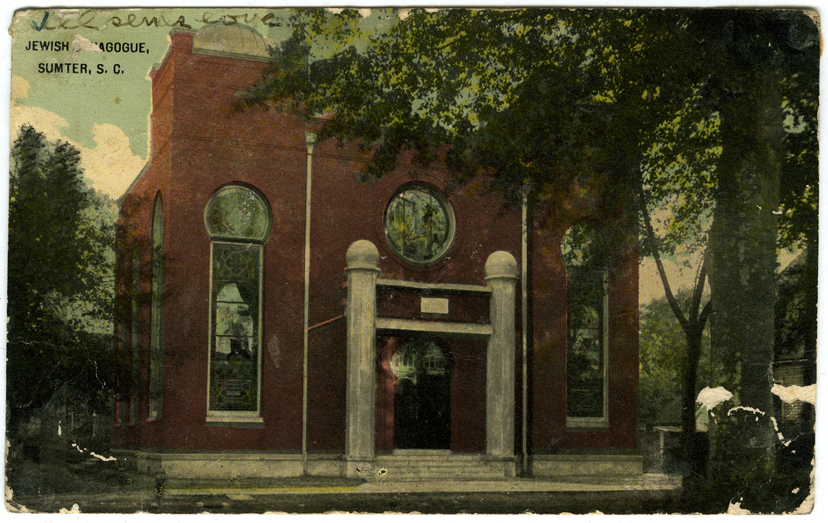4.9 Sumter, South Carolina
Temple Sinai, 11 Church Street
Architect unknown, 1913
Publisher and publication date unknown
Jewish settlers began arriving in Sumter about 1815, including members of such prominent Charleston families as Solomons, Moses, and Harby, some of whom claimed Sephardic heritage. The community swelled during the Civil War with refugees fleeing the siege of Charleston, and after the war members of the Cohen and Moïse families, among others, moved to the Midlands town. The Hebrew Cemetery Society was formed about 1874, the year that land for the Jewish Cemetery was purchased. The Sumter Hebrew Benevolent Society was organized before April 1881, according to its recorded minutes. These groups merged in 1895 to form the Sumter Society of Israelites, the official name of Congregation Sinai. Between 1895 and 1904, the young Society purchased a lot on the corner of Church Street and West Hampton Avenue to build a synagogue.
A wood-frame structure was built by 1906 but was probably designed years earlier, as Savannah architect Alfred S. Eichberg had produced plans for a synagogue for Sumter in 1892. By 1907, the congregation had adopted a constitution and its membership was growing.
The wood structure was replaced by the rectangular Moorish-style brick building pictured here, dedicated in the spring of 1913. The facade presents a prominent entrance where two projecting columns with bulbous tops flank a horseshoe arch. Two square corner towers that rise slightly over the facade roofline are topped with small domes. A much larger dome surmounts part of the sanctuary.
The sanctuary is noteworthy for its stained glass: a series of ten tall, narrow horseshoe-arched windows around three sides, each about five feet wide and twenty feet tall, and a large round window above the entrance. The vibrant figural views consist of handmade “drapery” glass, with thick rolling folds that create deep colors and a dimensional effect. The images depict scenes from the Hebrew Bible, including four that depict stages in the life of Moses. The architect of the brick building is unknown, as are the designer and studio of the tall windows. The window above the entrance identifies the manufacturer as “Empire Glass Co., Atlanta, Ga.”
Additions to the synagogue were made over the years and there was a substantial sanctuary remodeling in 1969. In the new century, facing an aging and dwindling congregation, Temple Sinai members began planning for the future. In 2007, the congregation donated its archives to the College of Charleston Jewish Heritage Collection and, beginning in 2015, forged a partnership with the Sumter County Museum, which sits a block away from the synagogue, in the former home of Andrew Jackson and Octavia Harby Moses and their descendants.
With oversight by Charleston’s Coastal Community Foundation and assistance from the design firm HW Exhibits, the social hall behind the sanctuary was transformed into the Temple Sinai Jewish History Center, which opened to the public in 2018. As of 2021, and for the foreseeable future, the sanctuary is available as needed for Sabbath and holiday services, as well as celebratory occasions and funerals.
